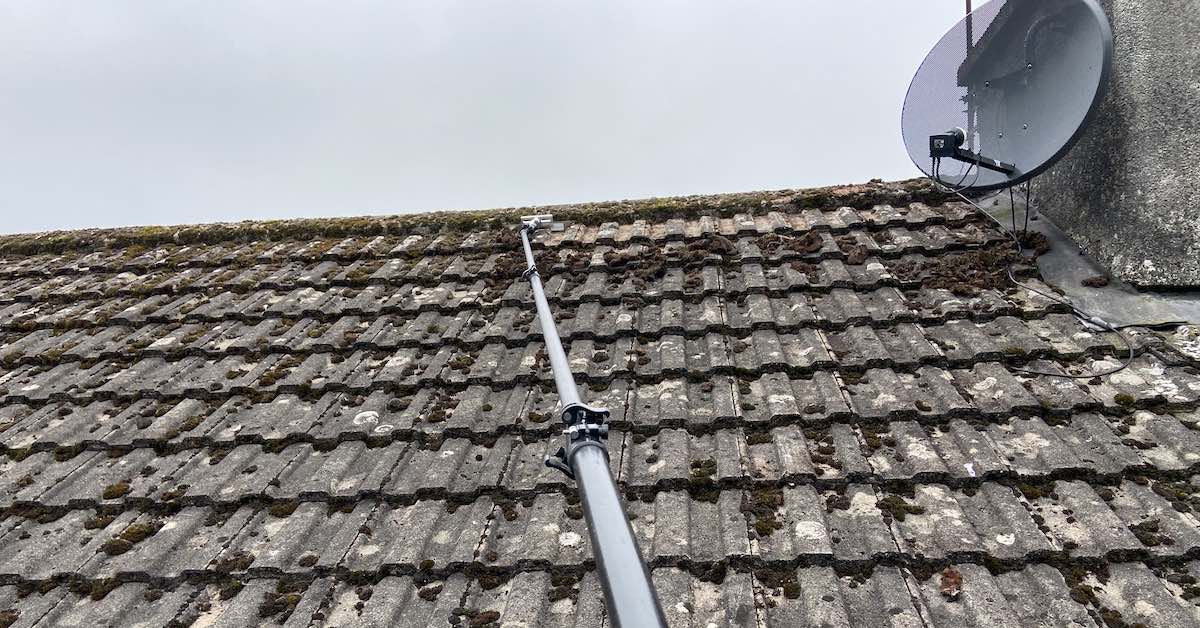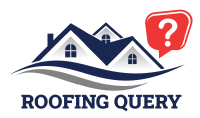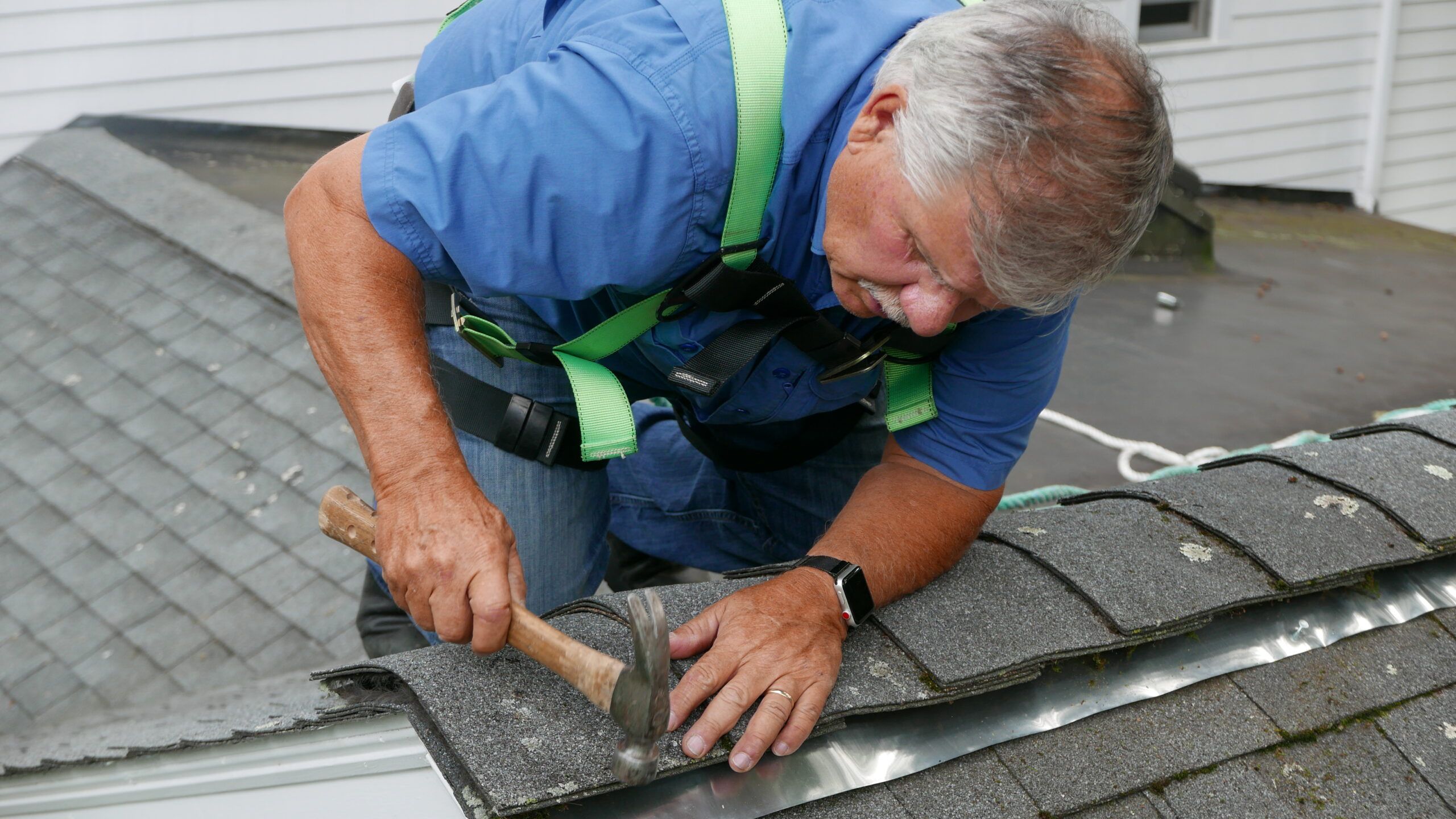To remove moss and algae from roofs, use a soft wash method. Apply a mixture of water and chlorine bleach to kill the growth without damaging shingles.
Keeping your roof free from moss and algae is crucial to extend its lifespan and maintain your home’s curb appeal. These unwelcome guests can cause serious damage if left unchecked. Homeowners often wrestle with the unsightly green patches that threaten the structural integrity of their rooftops.
As moss and algae thrive in damp environments, they’re most commonly found on north-facing or shaded sections of roofs where sunlight is minimal. Tackling this problem requires a gentle approach to avoid harming roofing materials. By adopting a proactive stance and utilizing the right techniques, you can safeguard your roof against these pesky invaders. Ready to take on this DIY challenge? Gear up with protective clothing, prepare your cleaning solution, and get ready for a clear, moss-free roof.
Understanding Moss And Algae On Roofs
A lush carpet of green moss or a streak of algae on a roof may evoke a sense of quaint charm, but they often spell trouble for homeowners. The presence of moss and algae is not just a cosmetic issue; it’s an invitation to potential damage that requires swift and effective action. Before tackling this unwelcome greenery, it’s essential to equip ourselves with the knowledge to correctly identify moss and algae, and understand the risks they pose to the longevity of our roofing structures. Let’s delve into recognizing the telltale signs and the underlying threats they propose.
Recognizing The Signs Of Moss And Algae Growth
Identifying moss and algae atop your roof can be straightforward if you know what to look for. Here are the key signs:
- Visual Indicators: Moss manifests as a thick, green layer that can appear as patches or cover large areas. Algae are often less conspicuous, displaying itself as black, blue, or green streaks that might be mistaken for dirt.
- Texture and Growth: Moss has a spongy texture and may elevate shingles due to its thickness. Algae, in contrast, forms a flat growth that does not affect the profile of your roof.
- Location and Climate: Moss and algae favor moist, shaded environments. Roofs with north-facing slopes or those shaded by trees are particularly susceptible.
Regular inspections, especially after wet seasons, can help catch moss and algae early before they become a notable problem.
Potential Damage And Issues Caused By Moss And Algae
Though often overlooked, moss and algae can lead to several underlying roof issues:
| Damaging Factor | Effect on Roof |
|---|---|
| Moisture Retention | Moss absorbs and holds water against the roof surface, leading to rot and deterioration of roofing materials. |
| Shingle Damage | The growth lifts and displaces shingles, compromising the roof’s protection and leaving it vulnerable to water infiltration. |
| Decreased Lifespan | Both moss and algae can shorten a roof’s lifespan by accelerating wear and tear, especially on asphalt shingles. |
| Aesthetic Decline | Unsightly streaks and thick patches can lower curb appeal and potentially reduce a home’s market value. |
Understanding the extent of potential damage moss and algae can cause is pivotal for homeowners, not only for maintaining the appearance of their homes but also for safeguarding the integrity of their roofs in the long run.

Credit: www.benzsoftwash.com
Diy Tips For Safe Roof Inspection
When it comes to DIY home maintenance, safety is paramount, especially when the task at hand involves scaling the heights of your roof. Moss and algae removal is a necessary chore to prolong the life of your roofing materials and to maintain your home’s curb appeal. Below, you’ll find crucial DIY steps to inspect your roof safely, ensuring that when you tackle that stubborn green growth, you do it without risking your well-being.
Preparing For A Safe Diy Roof Evaluation
- Before ascending your roof, ensure you have a stable ladder that extends at least three feet over the eaves.
- Wear non-slip shoes and consider a safety harness for added protection.
- Choose a dry, mild weather day for your inspection to prevent slipping on wet surfaces.
- Notify someone of your plans or better yet, have a partner work with you as a spotter.
- Carry a notebook or mobile device to record any areas that need attention.
Inspect your roof systematically, moving from one section to another to avoid missing any spots.
Identifying Key Areas Prone To Moss And Algae
Knowledge of where moss and algae typically thrive is crucial for a thorough roof evaluation. Be vigilant for:
- Shady areas that receive less sunlight and retain moisture—prime spots for growth.
- Sections of the roof where tree branches hang over, dropping debris that fosters an environment for moss and algae.
- Gutters and downspouts, as clogs can lead to water pooling on the roof, encouraging moss and algae proliferation.
- Places where previous growth has occurred, as spores can remain and lead to a recurrent problem.
Documenting these key areas will help you tackle the problem with an effective approach, focusing your cleaning efforts where they’re needed most.
Remember, while moss may lend a quaint, storybook look to your roof, its presence can cause significant damage over time. Regular inspections are critical for early detection and removal. By following these DIY tips for safe roof inspection, you’re taking an essential step towards maintaining a pristine and healthy roof free of unwanted moss and algae.
Eco-friendly Moss And Algae Removal Methods
Tackling roof moss and algae doesn’t have to involve harsh chemicals that can harm the environment. Eco-friendly methods can be just as effective and are safer for both you and the planet. In this section, learn how to use homemade solutions and apply natural remedies that keep your roof clear without causing damage. With these green approaches, you’ll preserve the integrity of your roofing materials, all while maintaining an algae and moss-free environment.
Using Homemade Solutions For Moss And Algae Treatment
Harnessing the power of household items for moss and algae removal can be a game-changer. These gentler options are not only effective but also environmentally sustainable.
- Vinegar – Acetic acid in vinegar can help in killing moss and algae. Mix equal parts water and white vinegar in a spray bottle.
- Baking Soda – Baking soda can neutralize moss and algae without harming plants. Sprinkle it over affected areas and follow up with a gentle scrub.
- Salt Solution – A salty environment is hostile to moss growth. Dissolve a cup of salt into a gallon of water and apply to affected areas.
Note: These solutions should be applied on a cloudy day to prevent the solution from evaporating too quickly and to ensure maximum effectiveness.
Tips For Applying Natural Remedies Without Damaging The Roof
Preserving your roof’s condition while cleaning is crucial. Follow these tips to ensure your eco-friendly cleaning efforts don’t lead to unwanted damage.
- Moderate Pressure: Use a low-pressure garden sprayer to apply solutions. High pressure can erode shingles or tiles.
- Gentle Scrubbing: If scrubbing is necessary, use a soft-bristle brush to prevent scraping off granules from shingles.
- Proper Timing: Apply treatments on a dry day after several days without rain, allowing the roof to absorb the solution thoroughly.
- Rinse Carefully: After the solution has had time to work, gently rinse off the roof with water, taking care not to oversaturate the shingles.
Remember to adhere to safety precautions when climbing ladders or walking on the roof. It’s always best to have someone else present to ensure your safety during such activities.
Enhancing Roof Longevity Post-diy Removal
The success of DIY moss and algae removal from your roof is only the first step towards ensuring a long-lasting and healthy roof. Once these unsightly guests are gone, the next crucial phase is to actively engage in maintenance that not only extends the life of your roof but also prevents future growths. Let’s delve into how routine maintenance and preventative strategies can keep your roof in tip-top condition post-DIY removal.
Maintenance practices after moss and algae removalMaintenance Practices After Moss And Algae Removal
Continual care is key to maintaining the pristine state of your roof after a thorough cleaning. Here are some essential practices:
- Regular Inspections: Keep a close eye on your roof, especially after severe weather conditions, to catch any early signs of moss or algae reappearance.
- Gutter Cleaning: Ensure gutters are free of debris. Clogged gutters can lead to water pooling, creating a hospitable environment for moss and algae to thrive.
- Trim Overhanging Branches: Increase sunlight exposure and reduce moisture by trimming back any overhanging branches.
- Proper Ventilation: An adequately ventilated attic reduces moisture buildup on the roof, discouraging moss and algae growth.
- Chemical Treatments: Use preventive treatments like zinc or copper strips, which release particles that inhibit organic growth with each rainfall.
Preventative Measures To Keep The Roof Clear
To sustain a roof free from moss and algae, it’s vital to implement preventative measures. This proactive approach lessens the likelihood of future infestations:
| Measure | Description | Frequency |
|---|---|---|
| Remove Debris | Keep the roof surface clean from leaves, twigs, and other debris that may hold moisture. | Bi-annual |
| Antimicrobial Sprays | Apply sprays designed to kill and prevent biological growths. | As recommended |
| Periodic Washing | Gently wash the roof with a low-pressure hose to prevent the accumulation of spores. | Annual |
By following these straightforward maintenance and preventative practices, you’ll not only enhance your roof’s durability but also maintain its aesthetic appeal, ultimately protecting your home from potential damage.
Professional Help Vs. Diy Removal Tactics
Moss and algae are not just aesthetic nuisances, but they can also deteriorate your roof if left unchecked. Choosing between professional help and DIY tactics for their removal is crucial for maintaining the integrity of your roofing material. Understanding the implications of effectiveness and cost, as well as knowing when to call in professionals, can help homeowners make the best decision for their situation.
Comparing The Effectiveness And Cost Implications
When it comes to removing moss and algae from your roof, the effectiveness and cost are two significant factors to consider. DIY removal tactics may appear cost-effective initially; however, without the proper tools and solutions, these efforts can be less effective and may lead to repeated applications or even damage to your roof.
| Method | Effectiveness | Cost |
|---|---|---|
| DIY | Varies depending on knowledge and tools used | Lower upfront, potential for higher long-term costs |
| Professional | High (due to expertise and specialized equipment) | Higher upfront, lower long-term costs |
In contrast, professional roof cleaning services come with a higher upfront cost but often provide a more thorough and long-lasting solution. Professionals use commercial-grade products and equipment, ensuring the moss and algae are removed effectively without damage to your roof’s shingles or tiles.
When To Consider Calling In Professional Roof Cleaners
Risk factor and expertise should guide your decision. If you’re experienced with home maintenance and comfortable working at heights, DIY methods might be suitable. However, consider the following scenarios for professional intervention:
- Extensive Growth: Widespread moss and algae require specialized treatment to prevent regrowth.
- Roof Safety: Steep, high, or slippery roofs pose significant risks.
- Material Care: Delicate roofing material demands expert techniques to avoid damage.
- Warranty Concerns: Some roof warranties could be voided by improper cleaning methods.
Professionals also bring the benefit of inspecting the roof for underlying issues that may be contributing to the growth of moss and algae. Their insights can prevent future problems and ensure the longevity of your roofing system. Professional assessment can ultimately save homeowners time and money, while preserving the health of their roof.
Frequently Asked Questions On Diy Tips For Moss And Algae Removal From Roofs
Is Roof Moss Removal Really Necessary?
Yes, moss removal from roofs is essential to prevent damage. Moss retains moisture against roofing materials, causing rot and deterioration. Timely removal extends roof lifespan and maintains its integrity.
What Are Safe Diy Moss Removal Solutions?
Safe DIY moss removal solutions include a mixture of water and gentle detergents or diluted vinegar. Apply with a soft brush and rinse thoroughly to avoid damaging shingles. Always prioritize safety when working on roofs.
Can Pressure Washing Remove Roof Algae?
Pressure washing can remove roof algae, but it’s risky. It may damage shingles and void roof warranties. Use low pressure and appropriate cleaners instead for a safer, effective cleaning.
How Often Should I Check My Roof For Moss?
Inspect your roof for moss at least twice a year, typically during fall and spring. Regular checks allow for early detection and easier removal, ensuring your roof’s longevity.
Conclusion
Tackling moss and algae on your roof is manageable with the right approach. Grab your gloves and tools; a cleaner, longer-lasting roof awaits. Remember, regular maintenance is key. For more home DIY insights, keep following our blog. Your safe, beautiful home starts here.

